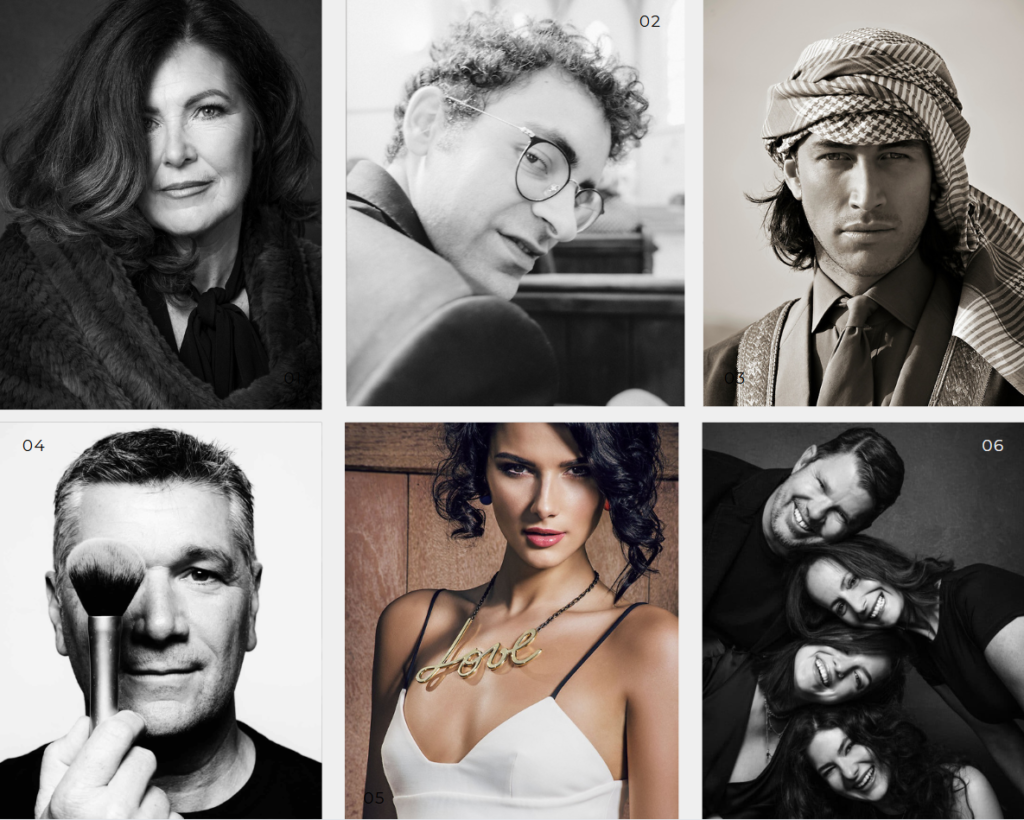Contact sheets
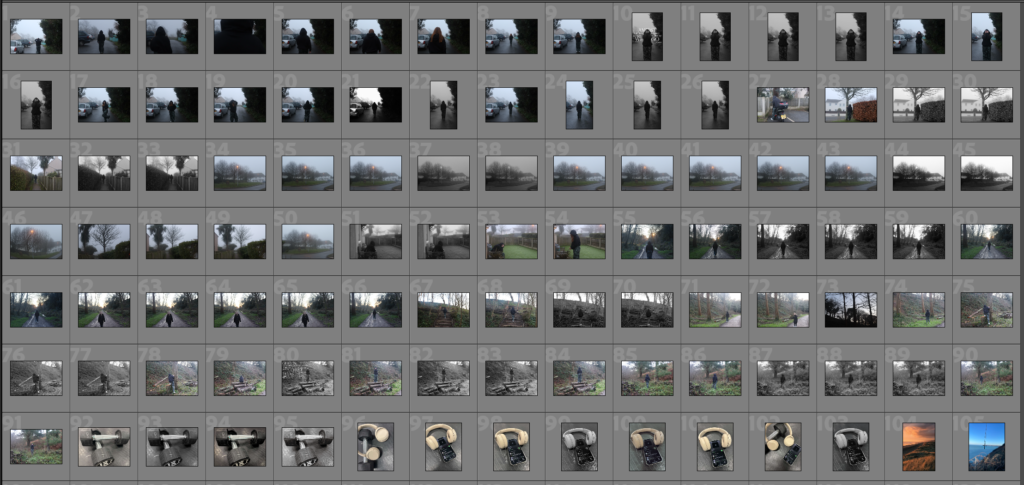
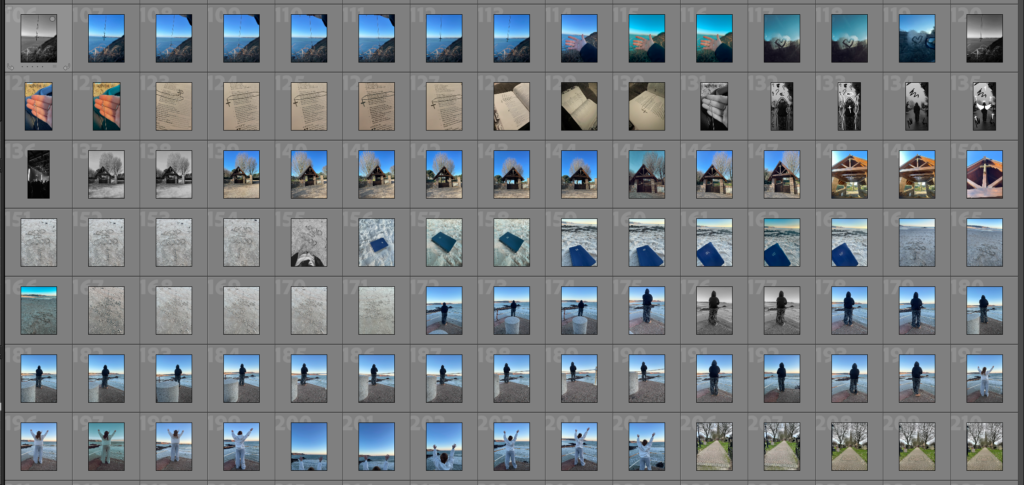
Best images
Here are two of my favourite images as I feel they both have really good composition and really capture the emotions of the images rather then just what is shown it really brings out the deeper meaning of the storyline.

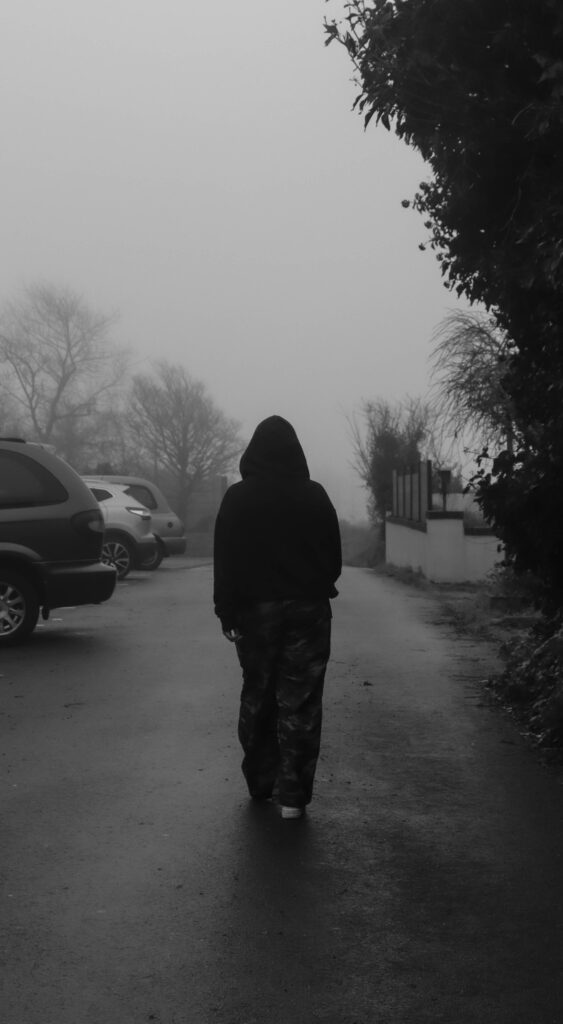
Contact sheets


Best images
Here are two of my favourite images as I feel they both have really good composition and really capture the emotions of the images rather then just what is shown it really brings out the deeper meaning of the storyline.


EDIT 1
lightroom editing
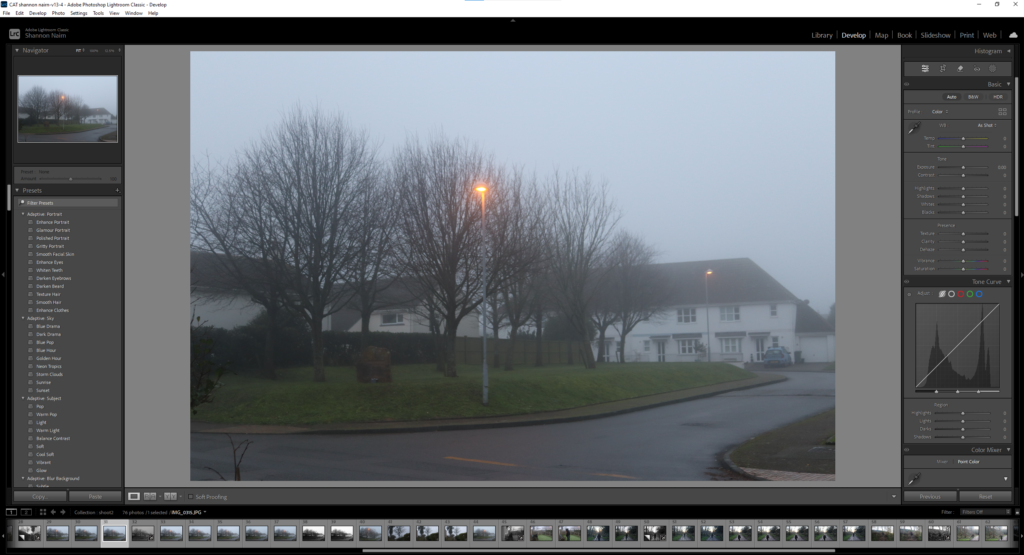
Here is the original image ^

I took the original image and changed it into black and white to create a more dramatic and moody atmosphere. By removing the colour, I tried to emphasize the shadows and contrasts, which helped in adding a sense of darkness and confusion. Through my editing, I enhanced these elements to give the image an intense, almost unsettling feel, giving a sense of uncertainty and confusion.
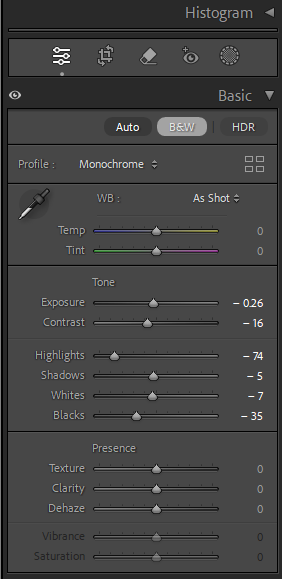
Here are the slight changes I made to the image.
EDIT 2
lightroom editing

Here is the original image ^

Again here, I took a different image and changed it to black and white to give off a more ominous and mysterious mood. By taking away the colour, I highlighted the contrasts and shadows, which expressed the sense of unease. Through some extra editing, I amplified these dark elements to create a feeling of uncertainty, adding a dramatic and intense effect to the image. I also added a blur on the images to show the confusion and representing being lost.

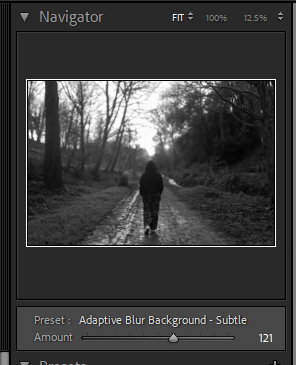

Virtual copy
Created a double to keep the original image and still be able to edit and play with the copy.
Edit 3
lightroom editing

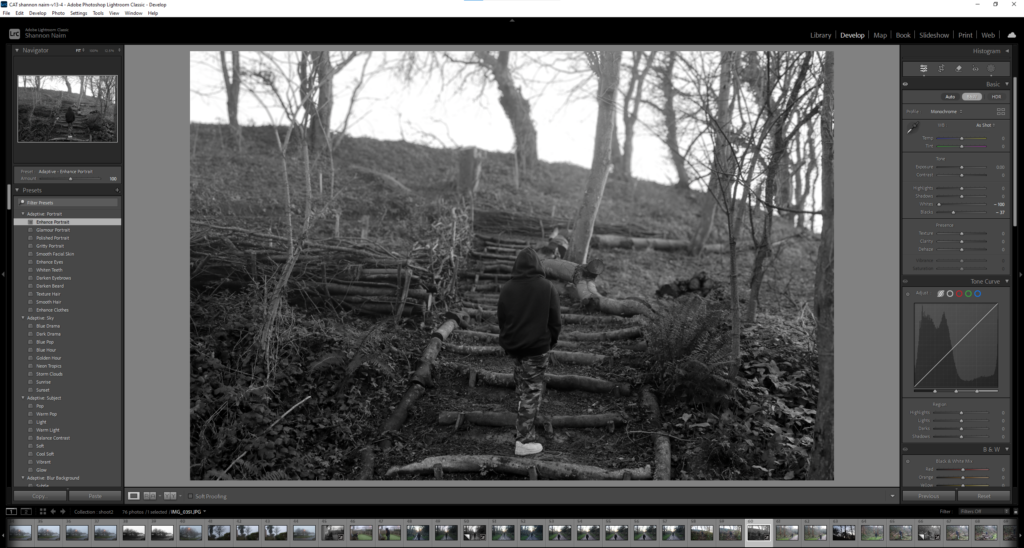
Edit 4
Lightroom editing

Here is the original image ^
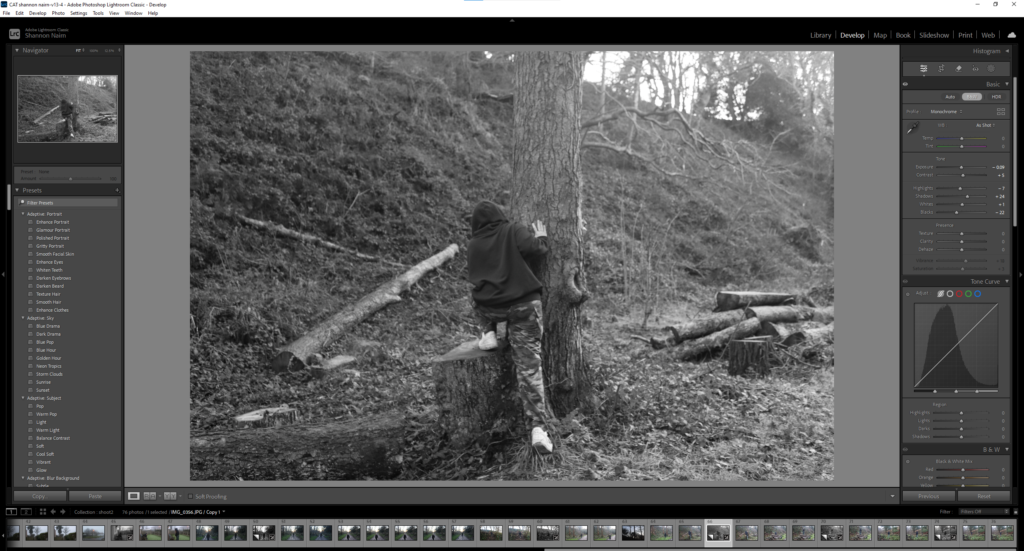

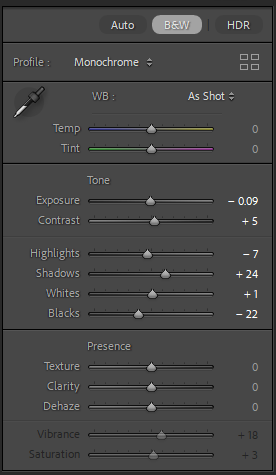
Edit 5
lightroom editing
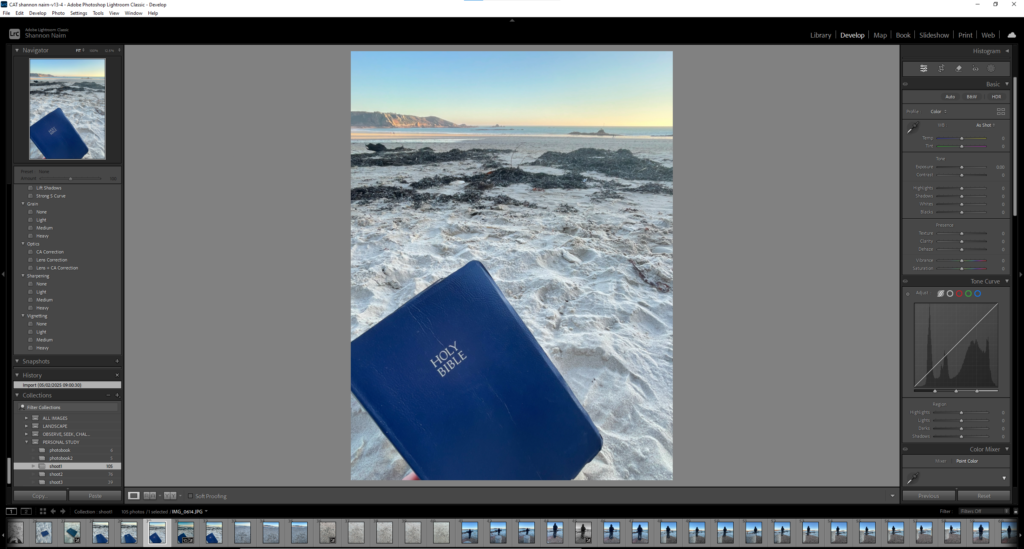
Here is the original image ^

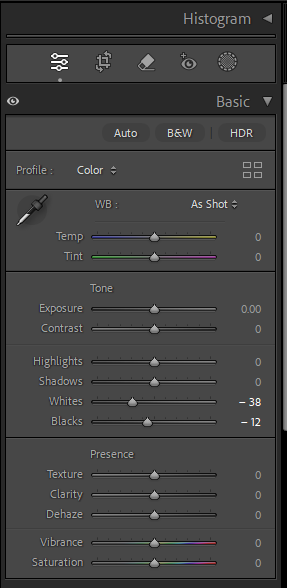
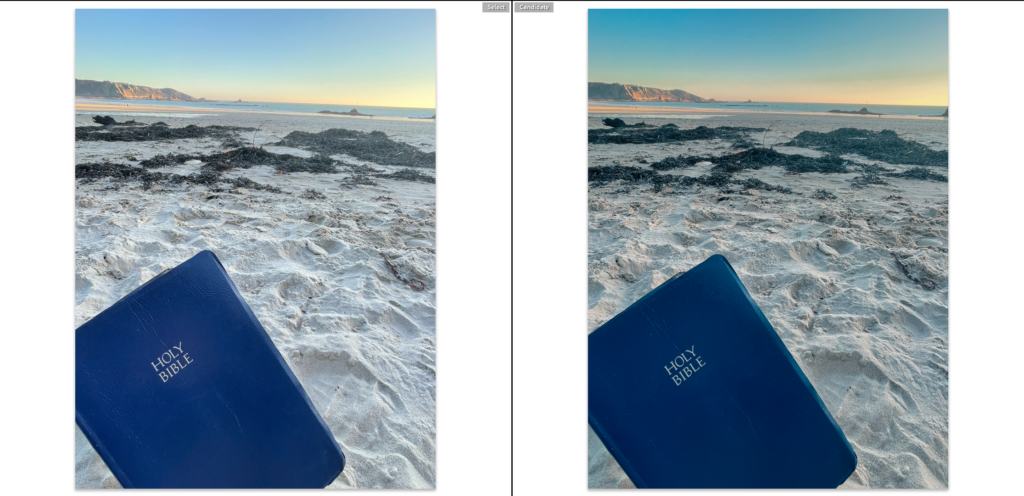
Edit 6
lightroom editing

Here is the original image ^

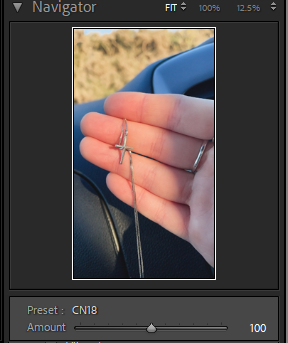
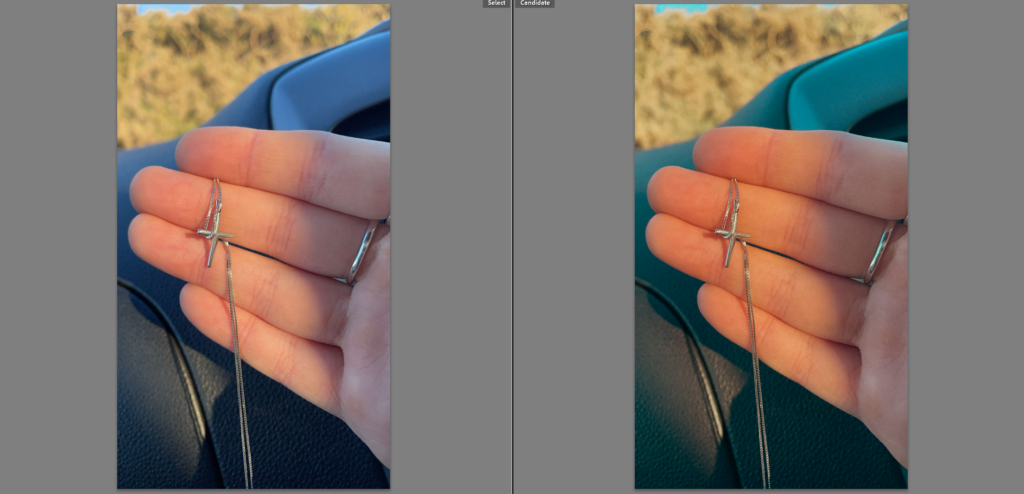
edit 7
lightroom editing

Here is the original image ^
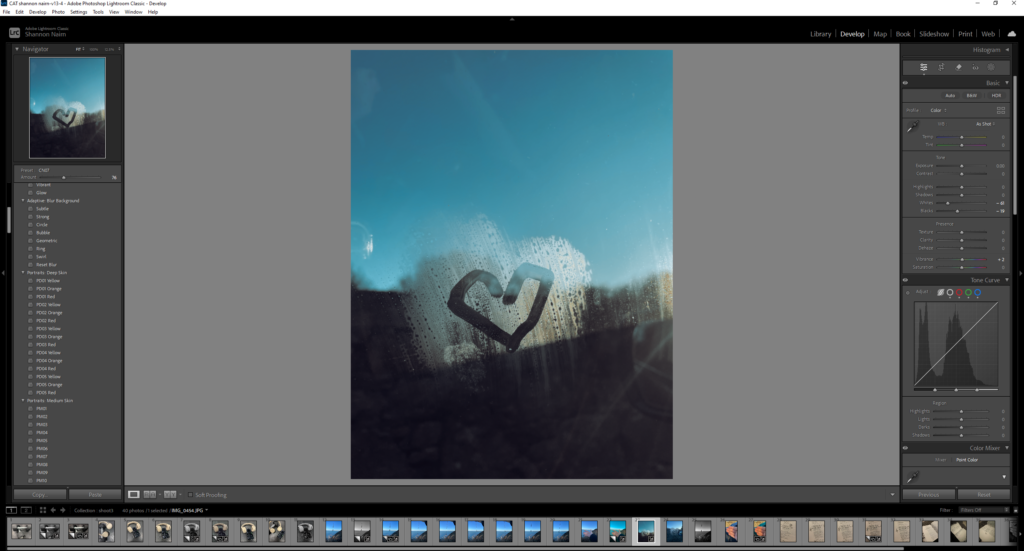


edit 8
lightroom editing
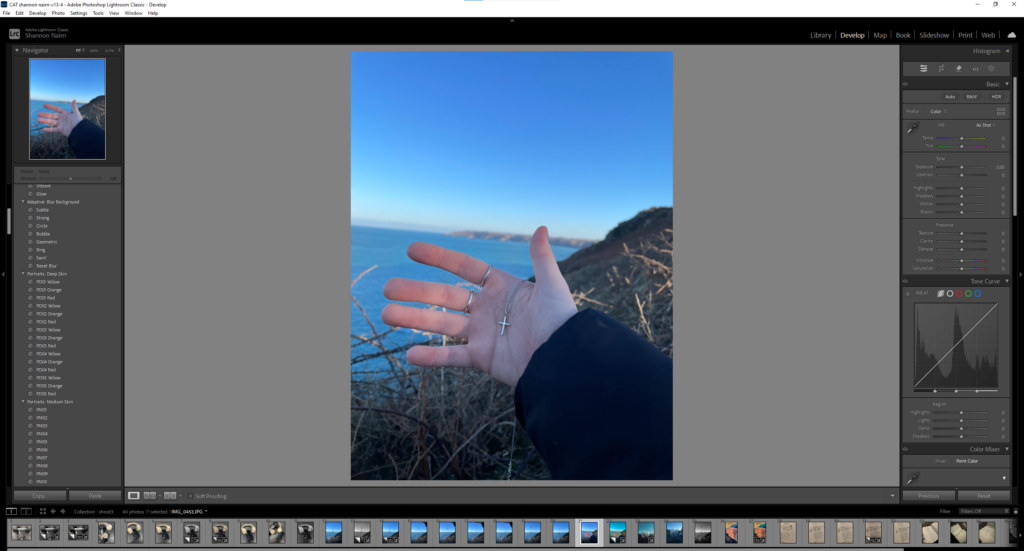
Here is the original image ^
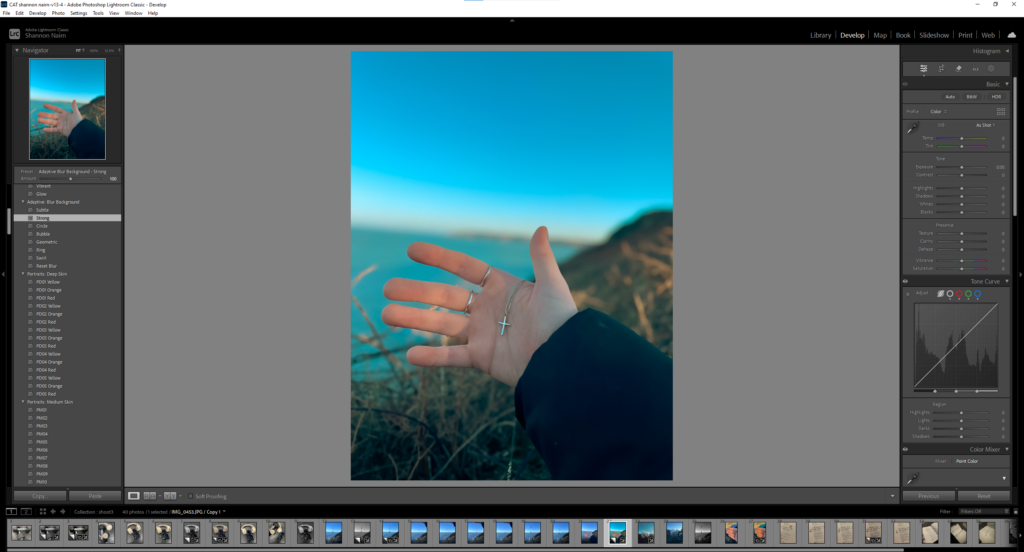

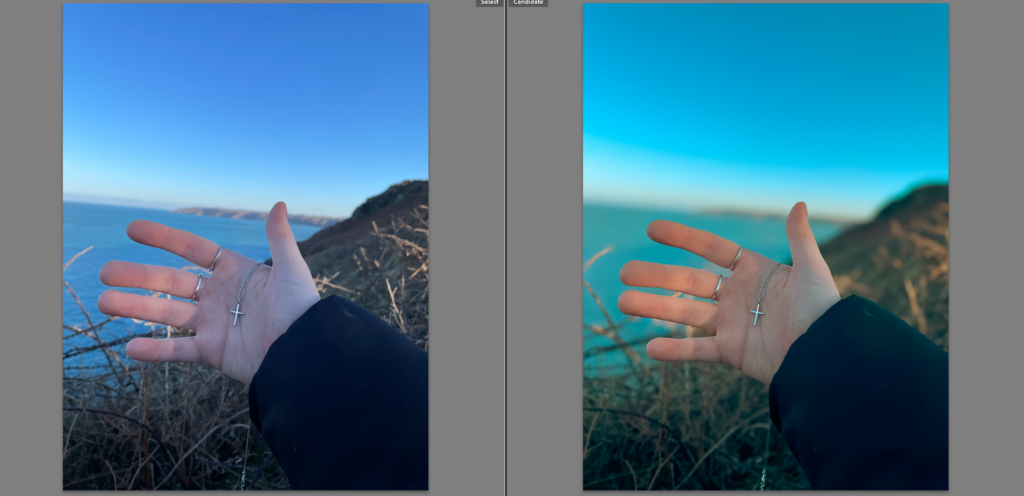
edit 9
lightroom editing
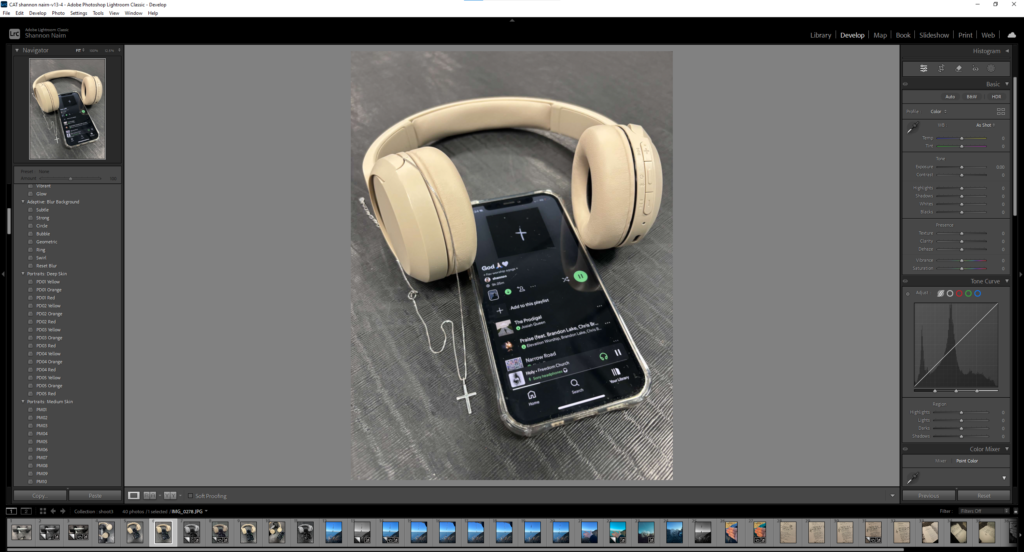
Here is the original image ^

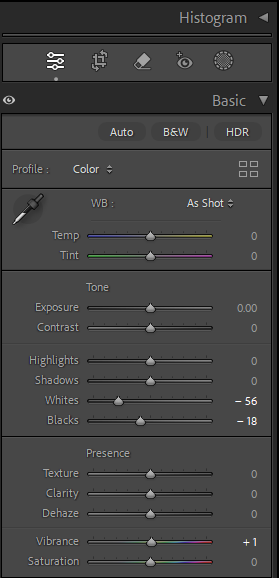
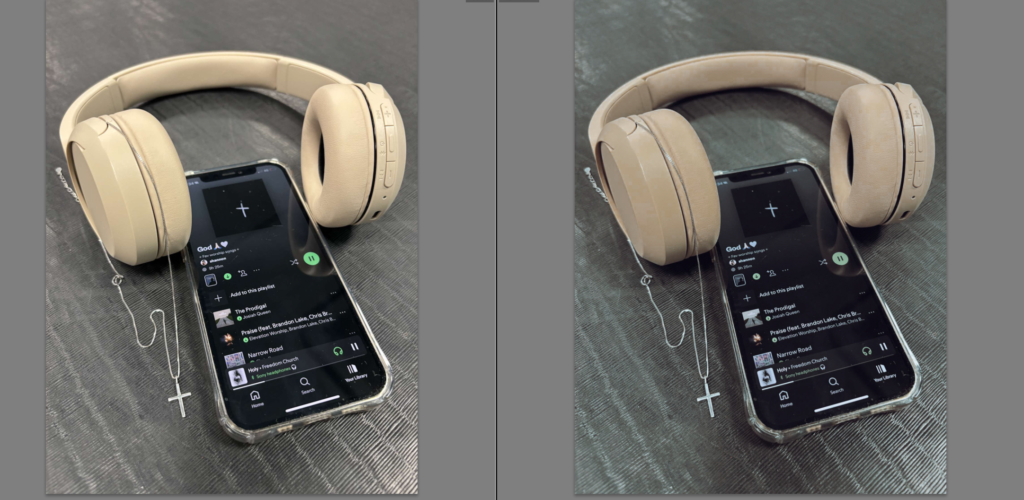
edit 10
lightroom editing
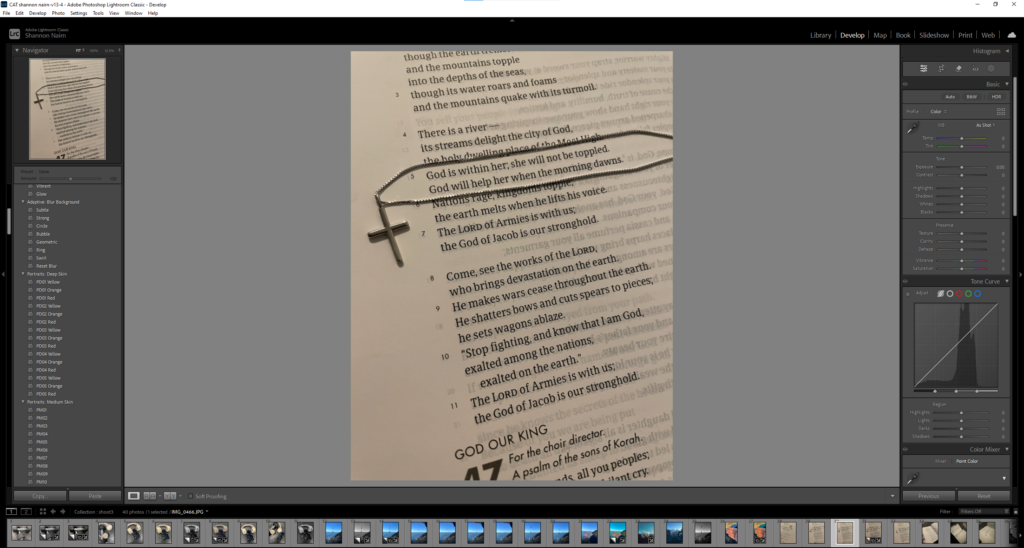
Here is the original image ^

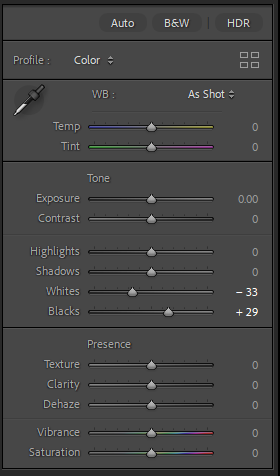

edit 11
lightroom editing
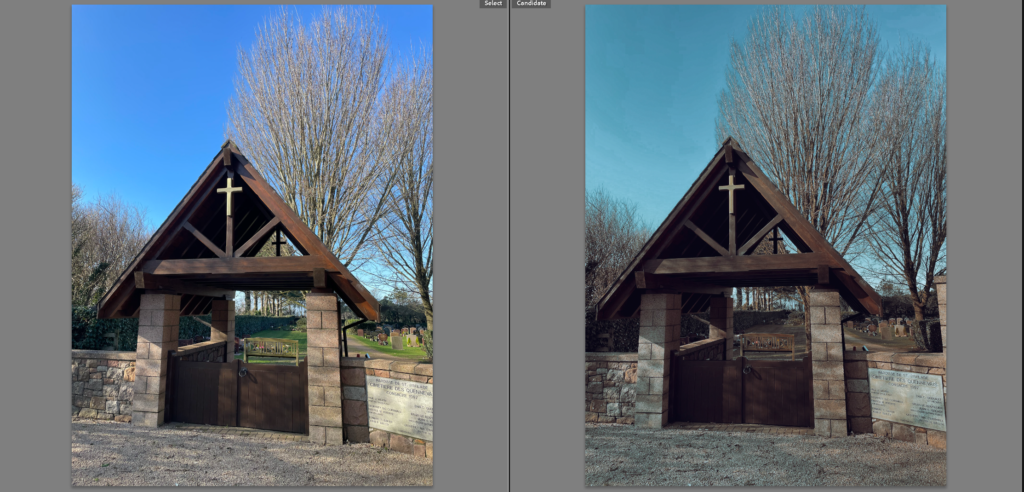
edit 12
lightroom editing
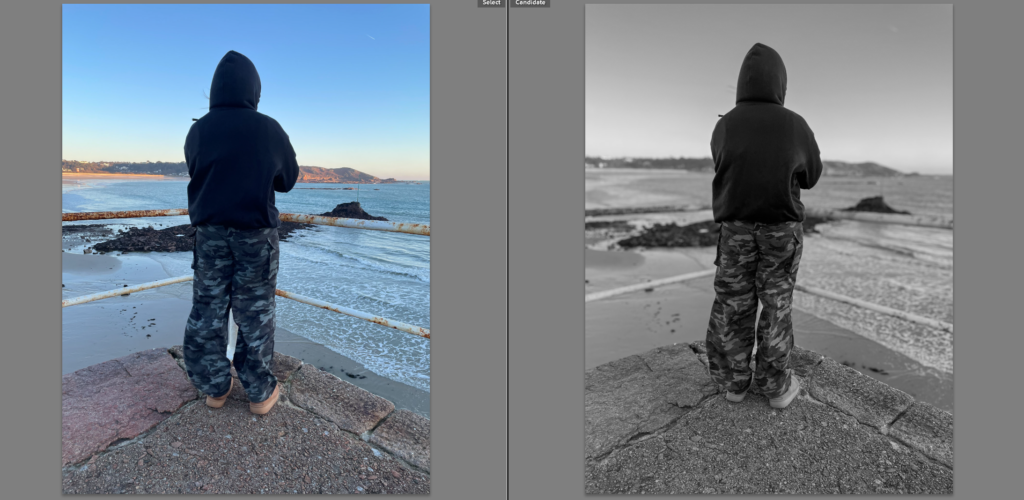
edit 13
lightroom editing
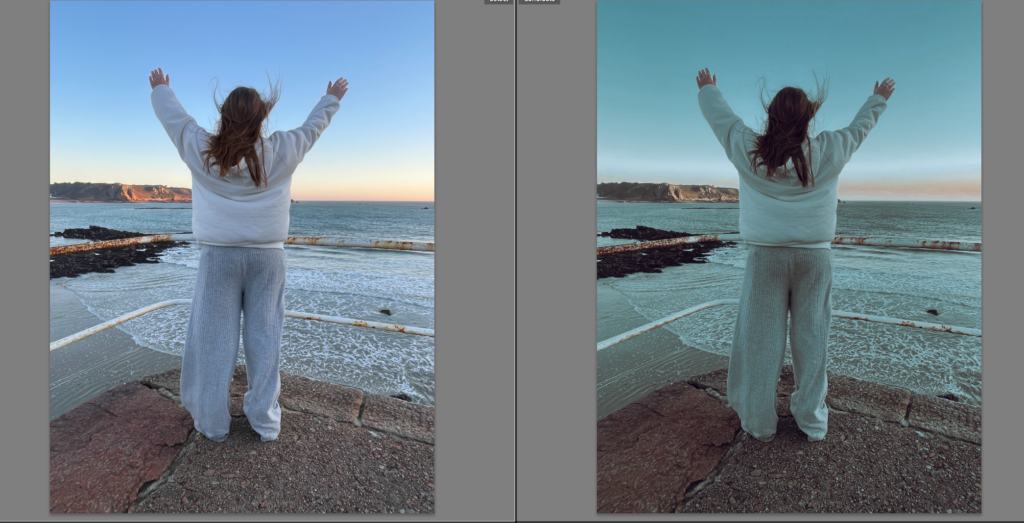
edit 14
lightroom editing
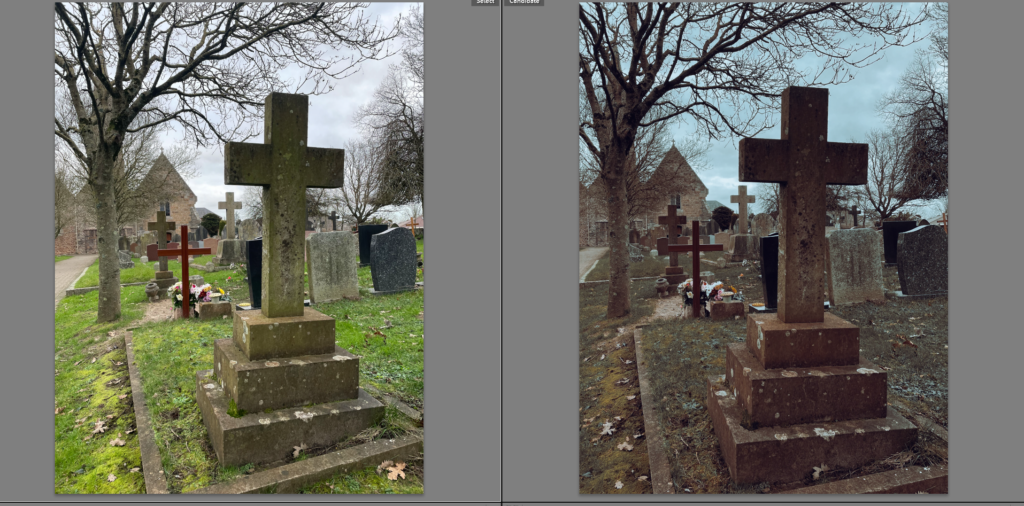
Writing page for the photobook
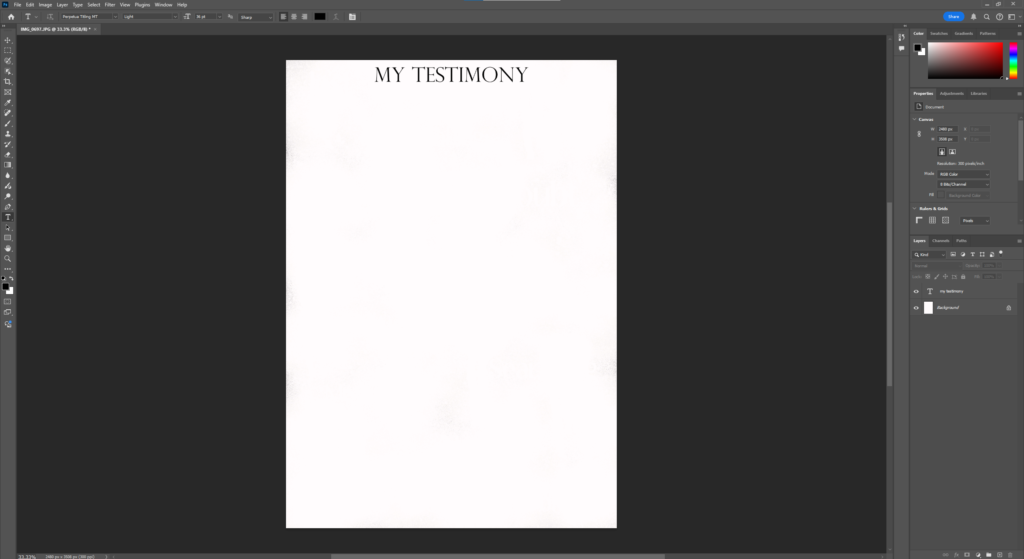
Font : perpetua tilting mt

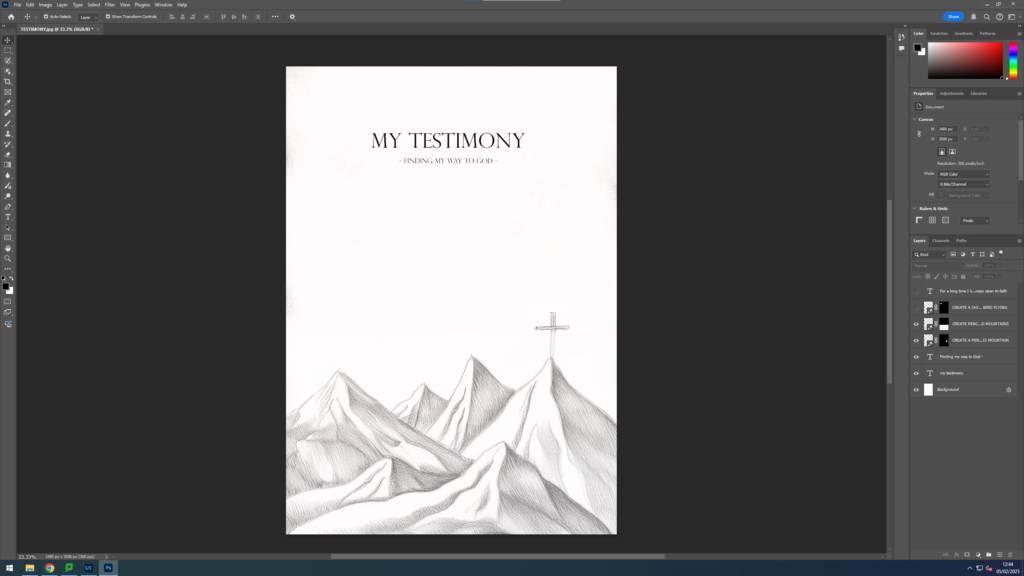

Narrative –
My Photobook Design
For the title I had a few ideas, I originally came up with calling it “chosen” I had originally decided on this as it was relevant to the fact that I feel chosen by God. However I then also decided that I also liked the name “ichthus” This one has a lot of meaning, in Greek this word means ‘fish of Jesus’. It has more hidden meaning than just that, each letter stands for something individually. the overall meaning is ‘Jesus Christ Son Of God Saviour’ I felt this would have been a really good title for my photobook as it represents what my photobook was about and the story behind it. In the end I decided to call it ‘Captured by the Spirit’, I decided on this as it not only incorporates the fact I captured the images with my camera but also the fact that the Holy Spirit had entered me almost as if it was representing the fact it captured my life. I really liked the fact it was representing two things at once, one being the literal camera capture of photographs and the other being the metaphorical capture of being taken by the faith.
The whole idea :
For my personal study project I have chosen to explore the theme of faith and religion through documentary photography. As I had grown up in a completely atheist household finding my way in faith is very special to me and has been an incredible journey as it’s one I’ve had to navigate by myself. Within this project I aim to present my journey with faith and how it has changed my life but to also represent how much things can change and the emotions surrounding these changes before and during my walk of faith. I intend to create a series of both landscape and portrait images of both myself and anything to do with the events in which I attend as a Christian.
Photoshoot one & two –
Concept –
For my first photoshoot I want to explore the feeling of being lost in the dark and confused while trying to find my way before finding my faith. To capture this I plan on using a low-light setting perhaps on a day when its quite gloomy, foggy and I would go to a forest or somewhere dark to show the confusion and lost emotions. Ill experiment with shadows and dramatic contrasts to create a sense of isolation and searching. This photoshoot will represent the emotional struggle and uncertainty before finding clarity and faith.
Location –
I went around the Island to different Locations, some of the images were taken on St Brelades beach while others were taken at St Peters reservoir and I had even taken some near my house and some from random nature walks on the island.
Equipment –
Artist reference for this shoot –
For my personal study project I have chosen to explore the theme of faith and religion through documentary photography. As I had grown up in a completely atheist household finding my way in faith is very special to me and has been an incredible journey as it’s one I’ve had to navigate by myself. Within this project I aim to present my journey with faith and how it has changed my life but to also represent how much things can change and the emotions surrounding these changes before and during my walk of faith. I intend to create a series of both landscape and portrait images of both myself and anything to do with the events in which I attend as a Christian.
I will experiment with different positions, angles, lighting, weather conditions and other factors and will use post-production editing skills to capture both the outside picture but also the deeper emotions that come with each individual image. I am particularly interested in looking at symbols through drawings I will do during the editing overlapping the images to represent the emotions. The main centre theme of my study is religion and faith both which hold very different meanings yet also very similarly bond together.
For my project, I want to focus on capturing emotions through natural light and also added drawings in post-production and exploring how it can completely change the mood of an image. My goal is to experiment with different times of day and weather conditions to see how they affect the atmosphere and feel of my photos. I also want to push myself to get better at presenting a story through my images. Perhaps by using dramatic shadows, soft lighting or even artificial lighting to create contrast. Overall I want my work to make people feel something through my photos whether that be a moment of connection to my work or even just a second of curiosity.
I am really inspired by the work of Henri-Cartier Bresson and the way he uses documentary photography to tell a story and represent certain emotions and situations. I have also been looking at Arnold Newman and I love how he uses Environmental portraiture to again represent a personal story behind every individual he photographs. For my project, I want to take all of these ideas and experiment with them in my own way. Ill research more about their techniques and figure out how I can apply them to my theme of work whilst also making sure my work feels personal and unique to me.
For my personal study I am going to be using my Canon camera because it gives me the flexibility to experiment with different settings and lenses, especially when playing around with the depth of field and lighting. I will also be using editing software such as Lightroom to enhance the mood and the colours in my images. I also really want to experiment with using natural light like doing shoots during sunset and also whenever the weather is foggy and gloomy.
With my shoots, I am planning to focus on a mixture of portrait and landscape images depending on the type of images I need for the specific shoot. I will end up with a variety of different formats and sizes with my images. Ill probably shoot in a few different locations for example, my local church, my actual church, the forests, nature walk areas, beaches, my own house and possibly even more to get a variety of different settings and moods. I want to experiment with different compositions; some wide shots to capture the context and some close ups to get every little detail.
By the end of my personal study project I hope to have multiple sets of images that not only show how much I’ve improved with all the technical side of photography but also to tell my story and create meaningful feelings through the photoshoots. I would like to be able to look back on this project and see that I have done it to my full potential and pushed myself to try out new techniques and ideas, even if some of them don’t work out perfectly. This personal study project gives me an opportunity to step out of what I am comfortable with doing in photography and explore something I’m genuinely passionate about and I am very excited to see it all come together within the final photobook.
The book I have chosen to look at is called “half- story half-life” it seems to create a story based on perhaps masculinity and the teenage youth among boys, trying to discover their identities and bonding with one another as friends. All the images are set in a forest Using documentary style photography to create a story as although they know he is there taking photos the images are not staged as such and are just showing the adventures of the teens. I feel the story could be representing the fact they might be trying to escape reality, showing that they are care-free and just enjoying life hanging out in a forest. I also got the impression that it could perhaps also represent how males/teen boys tend to be more risk taking hence why some of the images show the boys jumping off cliffs into a natural lake. In almost all of the images the boys have no clothes on the top half of their body which also shows their muscles which could be relating more to the masculinity side of things showing again their strength and more risk taking behaviours that females arguably don’t have as much of.

Some of the images from this book:
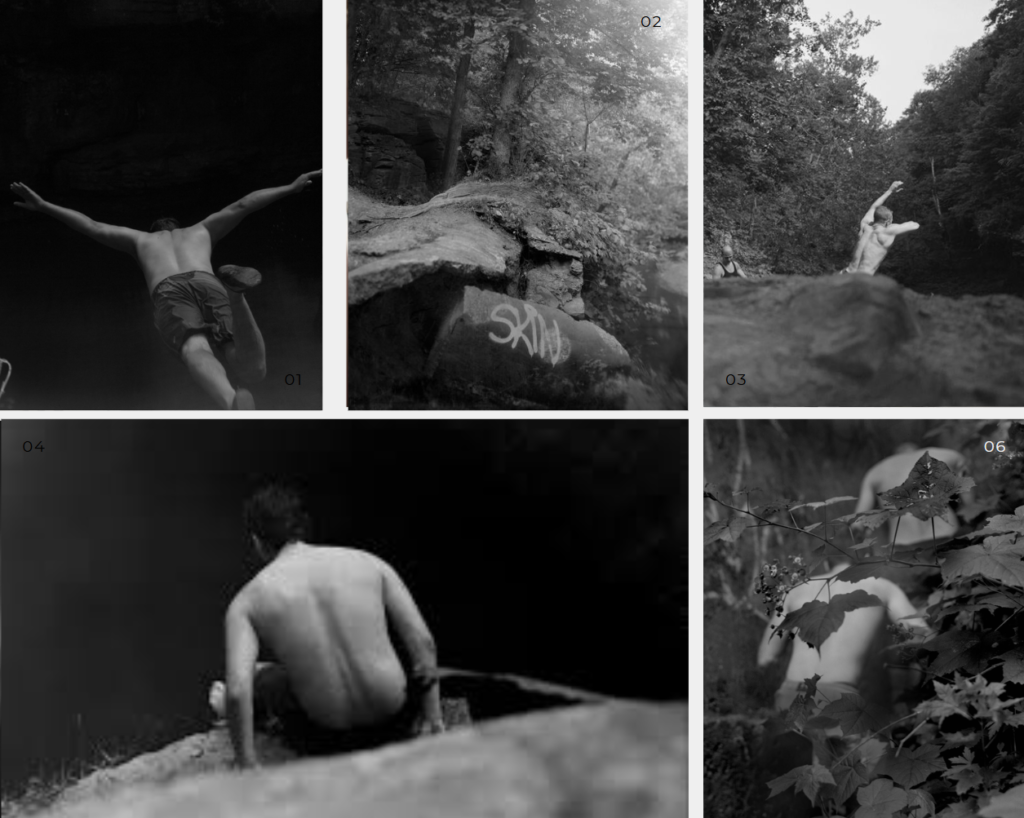
2. Who is the photographer? Why did he/she make it? (intentions/ reasons) Who is it for? (audience) How was it received? (any press, reviews, awards, legacy etc.)
The photographer of the book is called Raymond Meeks. Raymond Meeks is a photographer who was born in Ohio in 1963, he has been recognized for his books and pictures centered on memory and place, the way in which a landscape can shape an individual and, in the abstract, how a place possesses you in its absence. His books have been described as a field or vertical plane for examining interior co-existences, as life moves in circles and moments and events, often years apart that unravel and overlap, informing new meanings. Raymond Meeks lives and works in the Hudson Valley, New York. He gains inspiration by book narrative and collaboration with writers of poetry and short fiction and the merging of image and text. Half story Halflife, his recent body of work, is a visual biography of the post-teen age, in a specific time of the year, that leads from blizzards on unknown paths to leaps into darkness. The audience in which Raymond Meeks targets with his photo-book is summer dwellers (which is people who enjoy summer and make the most of it). Raymond Meeks’ photobook named “half-story half-life” was big among those especially youth who were also adventurous and could relate to the images within their own lives. Here is what Raymond Meeks said about what he had gained whilst and after creating this photobook “It was ritual. I was raised Catholic, so these rock outcroppings to me were like altars. These bodies leaping into the dark void almost became like this sacrament. I feel like each generation has to pay for the sins of the previous generation. They were almost offering up their bodies and it’s the process of evolving by way of ritual, that process of coming of age, something that’s been going on at this specific place for as long as people can remember” This quote actually somewhat relates to the study that I am doing as he also bases his personal faith around the images he takes and find references to how he was raised as a catholic.
3. Deconstruct the narrative, concept and design of the book and apply theory above when considering:
Book in hand: how does it feel? Smell, sniff the paper.
The book I have felt quite heavy and the cover was smooth feeling. The smell of the book was also almost musky it smelt rather old even though it was actually fairly new. It also had that distinct paper smell.
Paper and ink: use of different paper/ textures/ colour or B&W or both.
The paper of the book was in between both thin and thick paper it had a gloss coating on the paper which gave it a smooth texture. Each of the pages were white paper ages whilst all the images were in Black & White which gave the book a nice contrast in colour.
Format, size and orientation: portraiture/ landscape/ square/ A5, A4, A3 / number of pages.
The book “Half-story Half-life” is an A4 sized photobook in portrait format. There are 144 pages in the book and of those 144 pages 142 of them are pages with images on them.
Binding, soft/hard cover. image wrap/dust jacket. saddle stitch/swiss binding/ Japanese stab-binding/ leperello
The book I am looking at has a Soft cover where small sections have all been folded and held together before being glued to the cover. The cover is a faint image from the book imprinted on both the front and back of the cover as it loops around.
Cover: linen/ card. graphic/ printed image. embossed/ debossed. letterpress/ silkscreen/hot-stamping.
The cover is a soft card with an image from the same photoshoot presented in the book that is enveloped on the cover on both the back and the front.
Title: literal or poetic / relevant or intriguing.
The title of Raymond Meeks’ photobook title, Half-Story Half-Life, could be described as a reflection on the fragmented nature of memory, personal experience, and storytelling, suggesting a blend of narrative and existence that is incomplete or in flux.
Narrative: what is the story/ subject-matter. How is it told?
The photobook captures teens cliff jumping. He went back over several summers to capture the youth doing these activities. It creates a story of youth and growing up. The images seem to symbolize the transition from adolescence to adulthood as it represents the youth jumping into the unknown almost like how the future is unknown showing how the teens are fleeting from youth and going towards adulthood and the uncertainties that come with it this is represented through the images of the boys jumping into the lakes off of cliffs and exploring a forest. It also represents the desire they have to move forward and the risks that come with it when they do that, as they take a leap of faith jumping forwards into the unknown of the water below its the same as taking that leap into adulthood not knowing what is yet to come. I feel the images can create many stories through them as another way I interpreted it was as if it was showing how males are more prone to taking risks. Almost as if the book was based around masculinity and representing male strength through the shirtless images.
Design and layout: image size on pages/ single page, double-spread/ images/ grid, fold- outs/ inserts.
The image sizes throughout the book varies. Meeks may have been doing this to create a bigger picture behind the layout as all the images are different sizes and are placed in different locations on the pages this could be trying to express how not everything in life is the same and out of order as nothing goes one direct way in life. and the stages of going through life can be different for everyone with different struggles etc. Every image in the book is a single-page spread, with most pages having one image to every two pages with the occasional two pages with an image each. With some pages being very empty this could perhaps be suggesting how nothing is yet complete and there are always gaps and areas yet to be filled in life.
Editing and sequencing: selection of images/ juxtaposition of photographs/ editing process.
Meeks has selected a variety of images for this photobook however they are all very similar and are all images of either the males exploring, walking around the forest or jumping off the cliff into the water. he keeps a very structed set of images he has chosen to follow the theme. Every image in his photobook is in a black & white aesthetic and the sizing of the images when laid out varies massively amongst the book. The images look reasonably edited while also being very natural and just kept to how he has originally captured them.
Sticky Mr Toft Leave a comment
DEADLINE: Essay Introduction Draft MUST be handed in Thursday 18 Dec 2024
DEADLINE: Final Essay MUST be handed in Fri 31 Jan 2025
Copy this essay plan into your own blog post, titled: Essay Draft:
Literary sources: Go to this blog post here: Theory: Literary Sources and copy relevant key texts relating to the subject of your essay and list in alphabetical order in your bibliography. In addition, find your own key texts in relation to artists selected for in-depth analysis in your essay and list these too. These texts could be interviews with the artist, or reviews/ critique’s written by others. See useful online sites/ sources here .
Essay Question
possible-essay-questions-to-investigate
Some examples of Personal Study essays from previous students:
Essay Plan
Make a plan that lists what you are going to write about in each paragraph – essay structure
What is the relationship between Henri Cartier-Bresson’s theory of the ‘decisive moment’ and subjectivity?
To What Extent Is An Insiders Point Of View Truthful In Documentary Photography?
How can photography bear witness to the ways of life and events of the world?
How can photography bear witness to the world ways of life and events of the world?
What is the relationship between Henri Cartier-Bresson’s theory of the ‘decisive moment’ and subjectivity?
faith fact and fiction reality vs staged
‘To collect photographs is to collect the world’ (Sontag 1977:3)
Essay introduction: convert draft introduction to final version.
Below is link to a blog post which will provide you with helpful guidelines if you are struggling to structure your essay or writing paragraphs.
ESSAY WRITING | 2024 Photography Blog (hautlieucreative.co.uk)
Documentary style shoots, story telling, seeking.
I’m going to analyse:
In exploring my faith, religion, and photography, Susan Sontag’s assertion that “To collect photographs is to collect the world” (1977:3) profoundly shapes my approach to this study. Photography, especially in its documentary style, allows us to capture the essence of human experience, offering a window into the diverse and intimate ways people express belief and spirituality. This approach aligns with my own work, where I draw inspiration from Henri Cartier-Bresson, whose work of the decisive moment in documentary photography influences my desire to capture fleeting but profound instances of faith and my journey. Much like Henri Cartier-Bresson’s ability to reveal the underlying truths of human life through spontaneous moments, I look to document the quiet, sacred expressions of my own faith, offering a visual narrative that reflects not just personal devotion, but also the universal experience of spirituality. Through documentary photography, I aim to present these sacred moments in a way that invites reflection on religion and belief, while showcasing the subtle, often unnoticed beauty of spiritual life. I chose documentary photography as I am trying to represent a story behind my photographs. I am going to be taking images showing the stages of how I went from the darkness of being confused, lonely and not knowing what to do in life and the journey of me slowly finding my way to God and starting my walk of faith as a Christian. I am going to represent this journey through various photoshoots that piece together my story in the style of documentary photography. One of my inspiration is Henri Cartier-Bresson and in this essay I will be investigating his theory of the ‘decisive moment’ and its influence on contemporary documentary photography. A second photographer I will be analysing in relation to the decisive moment is Konrad Hellfeuer who explore religion through a documentary approach to image-making. A third artist I will be looking at is Arnold Newman, a photographer who predominantly explores the subjects of geography, inequality, and the environment in his native region and in related places, using the aesthetics of black and white. He also uses documentary photography.
Documentary photography, as a medium, has been known for capturing the complexities of human existence, where it often frames social and cultural narratives within specific historical contexts. This approach of photography seeks to engage with reality, capturing moments in real time, moments that can only be captured once creating all sorts of stories and representing them through images. In the theme of faith and religion, documentary photography can serve as a powerful means to explore personal and collective spiritual experiences.
For my personal study, I’m focusing on the work of photographer Henri-Cartier Bresson and documentary photography. I will also look at his ability to represent a deeper meaning and story through different contrasts, shapes, angles, shadows as prescribed in his theory the decisive moment. According to Cartier-Bresson the decisive moment is ‘the simultaneous recognition, in a fraction of a second, of the significance of an event as well as the precise organization of forms which gives that event its proper expression.’ (Cartier-Bresson 1952). My interpretation of his theory is that he makes photographs of situations and people in that moment in time, creating images that would never be able to be replicated.
my image compared to Henri-Carter Bresson –
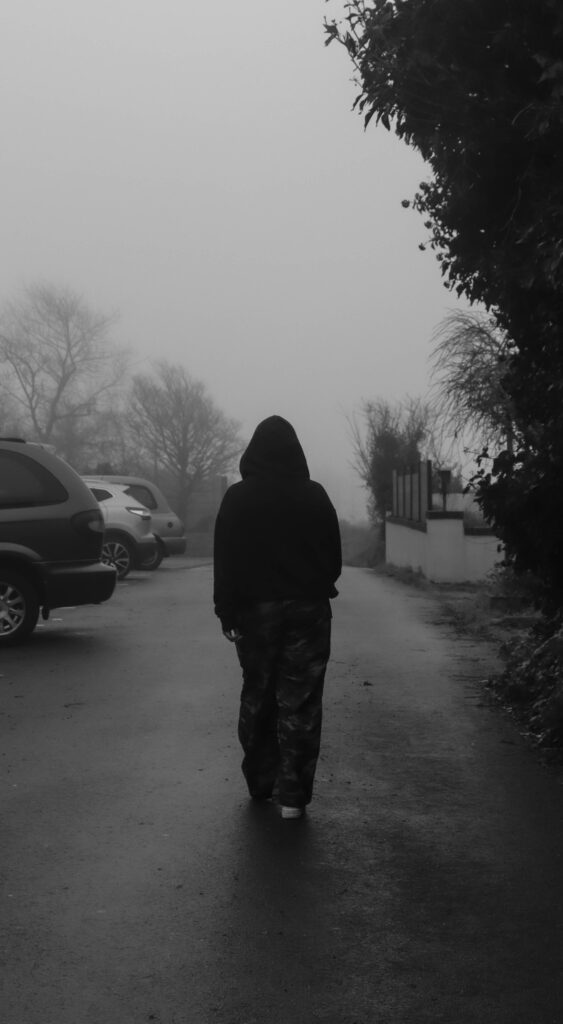
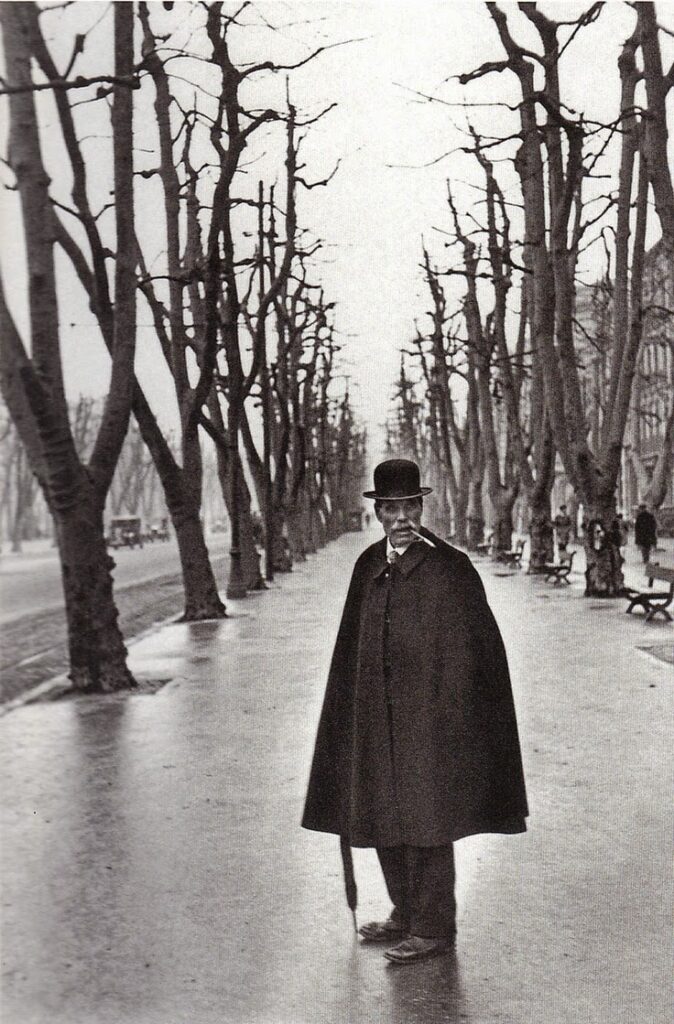
When comparing his work to my own images, I can see how I try to create a similar sense of emotion and storytelling like he does, though I tend to focus more on natural light and environments using the weather and location as it is without manipulating anything whatsoever.
In my first shoots, I experimented with capturing moments of genuine expression and emotions of how I was feeling in those moments which I believe aligns with Henri-Cartier Bresson’s goal of showing vulnerability and authenticity. Looking at both his work and my own, I realize how important it is to connect with the subject and take images in certain locations in order to really capture what I am looking for within my theme of faith and religion.
The second photographer I’m looking at is Arnold Newman, whose street photography captured everyday moments with a raw, storytelling and emotional feel. His use of positioning and angles really gives it a free feeling of being able to take images and capture real life images that can only be lived once, which is something I’ve tried to experiment with in my own work.
My image compared to Arnolds –
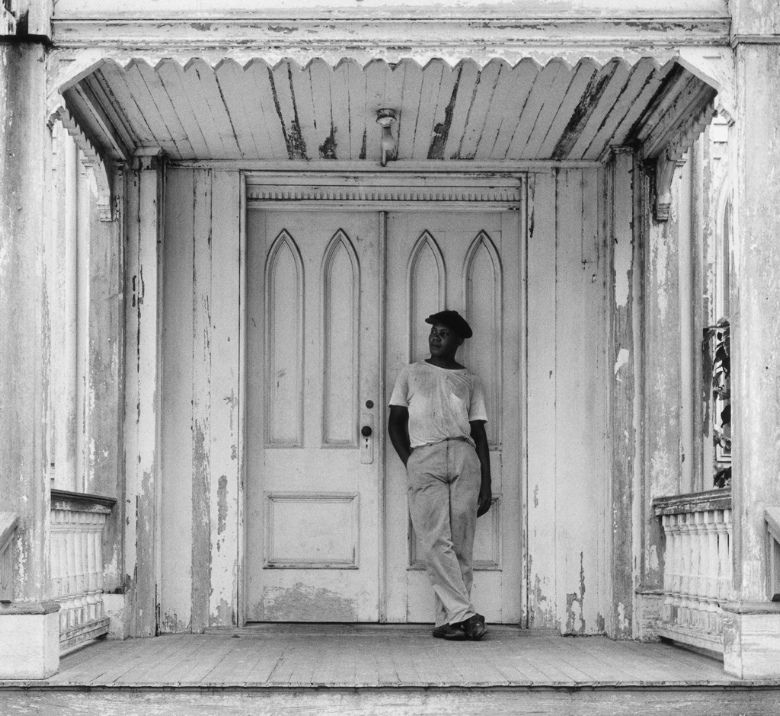
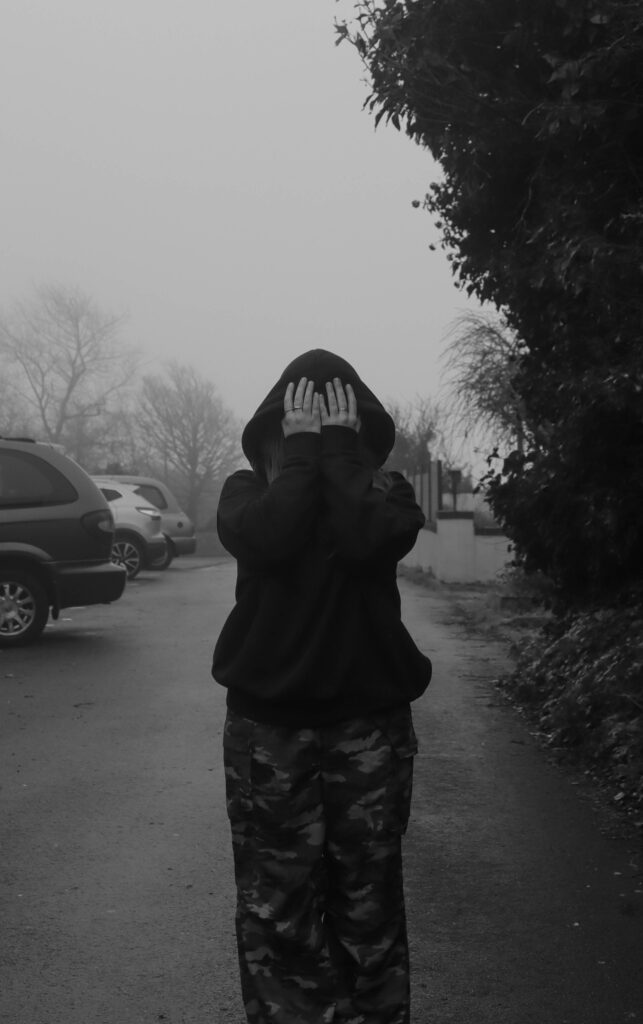
For example, in my second photoshoot, I focused on shooting people in the environment and just capturing people without them noticing, just like both Henri and Arnold did, as they both focus on in the moment circumstances where you can see peoples real emotions within those moments.
More of my images from the second shoot and evaluation
When I compare Arnolds approach to mine, I can see how I still have a lot to learn in terms of capturing that perfect moment of spontaneity. While Arnolds’ work often feels like he was in the right place at the right time, I sometimes feel like I’m more deliberate with my shots as I have tried to replicate a story and the emotions that come with it, of how both myself and someone else would feel when finding their path in faith.
Bibliography:
Documentary photography sources:
A short PPT on Documentary Photography
Wells L. (1998). ‘The Photograph as Document’ in Photography: A Critical Introduction. London: Routledge.
Bull, S. (2009), ‘The Photograph as Document’ in Photography. London: Routledge.
Bate, David (2016) ‘The Art of the Document’ in Art Photography. London: Tate Galleries.
– A text about how documentary photography now is considered within a fine-art context
Cartier-Bresson, H. (1952). The Decisive Moment. Gottingen: Steidl
Sontag, S. (1977) ‘In Plato’s cave’ in On Photography. London: Penguin Books.
Read interview here by The Guardian’s photography critic Sean ‘Hagan. Cartier-Bresson’s classic is back – but his Decisive Moment has passed
Listen to an audible comment from MOMA (Museum of Modern Art, NYC) here Henri Cartier-Bresson. Behind the Gare St. Lazare. 1932 | MoMA
Henri Cartier-Bresson Behind the Gare St. Lazare1932
Galassi, P. (2003). ‘And Everything in Between’ in Henri Cartier-Bresson: the man, the image and the world. A Retrospective. London: Thames & Hudson.
Clair, J. (2003). ‘Kairos: The Idea of The Decisive Moment in the Work of Cartier-Bresson’ in Henri Cartier-Bresson: the man, the image and the world. A Retrospective. London: Thames & Hudson.
The idea
I have come up with a second personal study idea which I am now using as my final idea where I would like to create a book through images representing my journey to God and becoming christian. I want to capture not only religious images but ones that show and create my own personal story of how I come to find God and interpreting my emotions throughout the images by using drawings on the images to represent my emotions I was feeling while on my journey.
Genres I want to include –
Artist references
Arnold Newman – Environmental Portraiture photography

Who is Arnold Newman?
Biography and his significance –
Arnold Newman was a photographer who became famous for his unique style of portrait photography. Born in 1918, he started his career with a love for capturing people in ways that were different from the typical posed studio shots. Instead of just focusing on their faces, Newman liked to include the person’s surroundings to show more about who they were. He photographed artists, politicians, and musicians, and his work became known for its depth and creativity. Newman didn’t just take a picture; he made sure his photos told a story about the person in them.
Environmental portraiture –
Arnold Newman is known for his “environmental portraiture,” which basically means he liked to take photos of people in their natural settings rather than just in a studio. Instead of posing his subjects in front of a plain backdrop, he’d show them in places that reflected their personality or work. For example, he might photograph a famous artist in their studio surrounded by their artwork, or a musician in a setting related to their music. This approach made his photos more interesting and gave you a sense of who the person was beyond just their face. It wasn’t just about taking a picture, it was about capturing the whole story.
His composition and lighting techniques –
Arnold Newman wasn’t just interested in taking a nice picture; he wanted to capture who his subjects really were. Before taking a shot, he’d spend time getting to know them, understanding their personality and background. This meant that his photos often felt personal and full of character. Whether he was photographing a famous artist or a politician, he made sure the photo showed more than just their face. The environment around them, their expressions, and even the little details all worked together to tell a story about who they were as people, not just what they looked like.
The stories he tells –
Arnold Newman’s photos weren’t just about snapping pictures of famous people—they were about telling a story through his subjects and their surroundings. He had a real knack for picking up on little details that gave you a better sense of who the person was. For example, he might photograph a musician in their studio, surrounded by instruments, or an artist in front of their own paintings. These extra elements helped make the photo feel more real and showed something deeper about the person, like what they cared about or what they did every day. It was like the setting became part of the story, not just the background.
Famous people and subjects –
Arnold Newman’s portfolio is full of famous faces, from artists to politicians, musicians to writers. He had a way of capturing these people in a way that went beyond just their fame. Instead of just a typical posed shot, Newman made sure to photograph them in settings that felt personal and meaningful to them. For example, he might snap a picture of a famous painter surrounded by their art, or a musician with their instrument in hand. These photos weren’t just about the celebrity—they told a bigger story about who they were and what made them unique.
Arnold Newman’s influence on other photographers –
Arnold Newman’s work didn’t just influence his peers at the time; it also had a big impact on photographers who came after him. His style of environmental portraiture, where the setting is just as important as the subject, became a major inspiration for a lot of modern photographers. Newman showed that portraits could be more than just nice pictures; they could tell stories and really capture the personality of the person. Today, many photographers still use his approach of including the environment to give their portraits more depth and meaning, keeping his influence alive in the photography world.
The people/things that inspired him –
Arnold Newman was heavily influenced by a variety of artists, photographers, and intellectual currents. One of his primary inspirations was Albert Renger-Patzsch, a German photographer known for his precise and objective style. Newman was also inspired by Berenice Abbott, an American photographer who focused on capturing urban environments and people in a direct, unflinching way.
Arnold Newman Moodboard

Personal Opinion
What I like about Arnold Newman’s work is that he uses people within their natural environment therefore he captures people to their full capacity as people often feel the most comfortable in their own personal environment. Although they do know they are being photographed many of the images still turn out very natural as if the camera wasn’t there.
Arnold uses quite a lot of natural lighting in his images, whether they are taken outside or close to windows letting in the natural sunlight and lighting in from the outside. Although all of his images are manipulated and changed to black and white the natural lighting within each image is still very clear and noticeable.
All of Arnold Newman’s photographs have a warm light feel to them even whilst all the images are black and white you can still see the warm, soft lighting within the photographs.
Arnold Newman uses a wide range of different perspectives, shapes and points of view within his images, some are up close and very detailed while others show a bigger picture with less of a focal point.
Henri Cartier Bresson
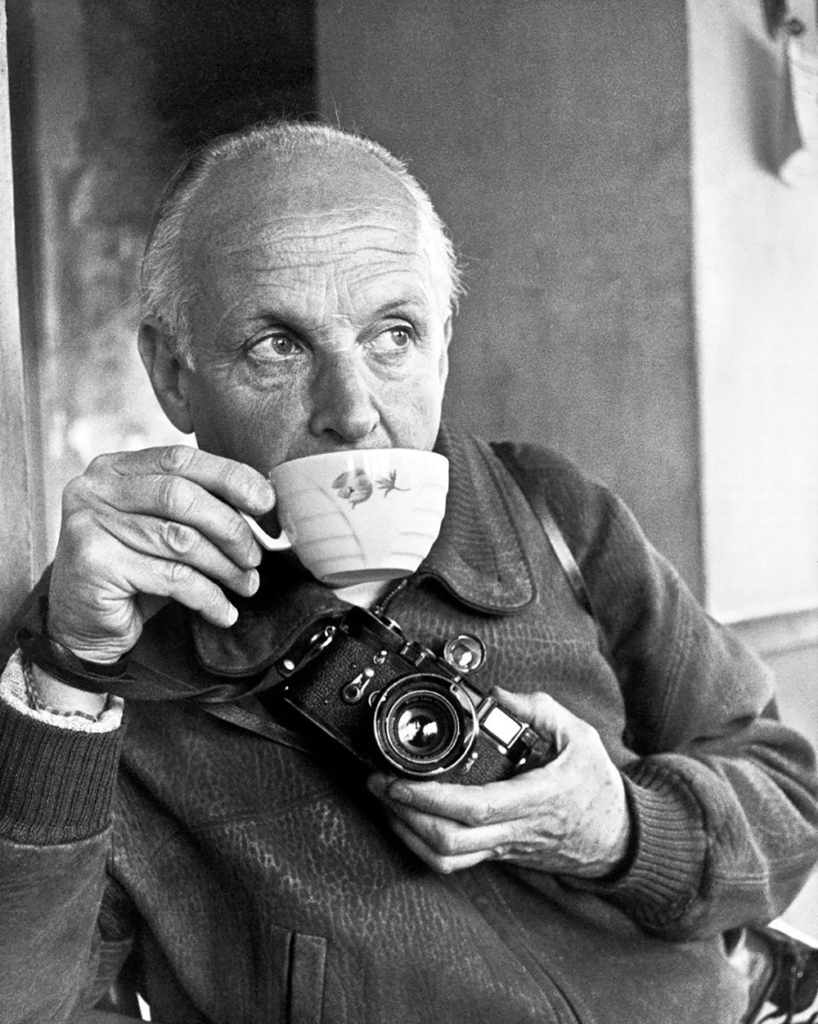
Who is Henri cartier Bresson?
Henri Cartier-Bresson was a French artist and humanist photographer considered a master of candid photography, and an early user of 35mm film. He pioneered the genre of street photography, and viewed photography as capturing a decisive moment. Cartier-Bresson was one of the founding members of Magnum Photos in 1947.
Who inspired Henri Cartier Bresson?
Cartier-Bresson’s photographic vision was shaped by a blend of artistic, philosophical, and documentary influences, ranging from Surrealism and Pictorialism to painting and the revolutionary spirit of the 20th century. His unique style, which emphasized capturing the essence of life’s fleeting moments, was an amalgamation of these diverse inspirations.
some of the types of people who inspired him:
What was Henri Cartier Bresson’s most famous piece?
Henri Cartier Bresson’s most famous piece was the Place de l’Europe, Behind Gare Saint Lazare (1932)
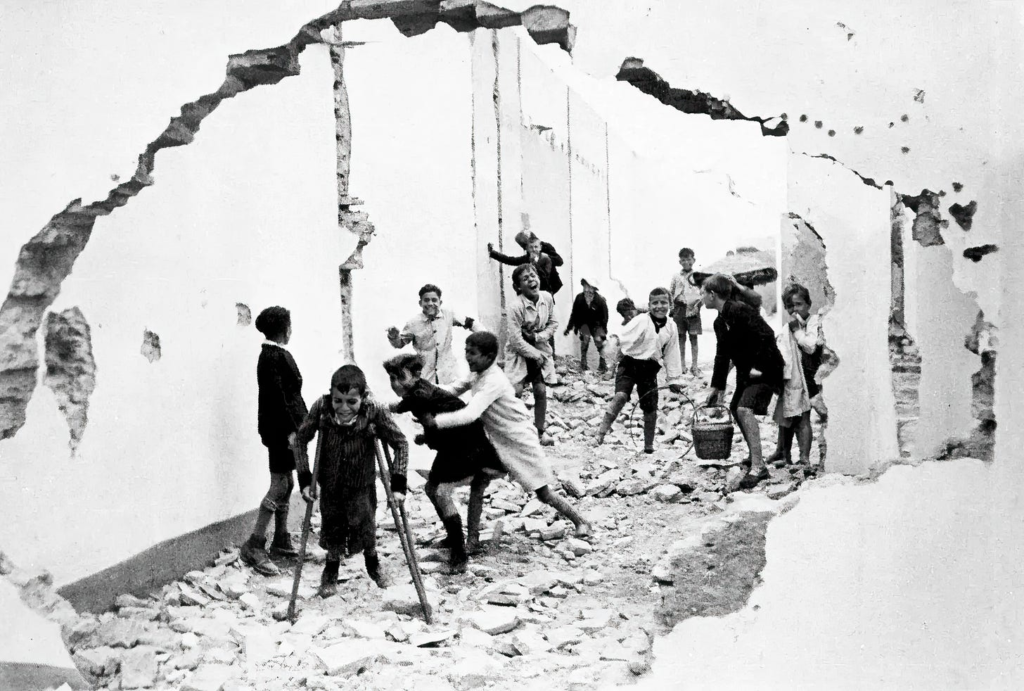
Image Description:
Cartier-Bresson’s impulsive masterpiece picturing a man suspended in mid-air as he hops over a large puddle creates a sense of anticipation as he captures the dynamic movement of an unaware participant in the decisive moment: the instant before his heel hits the water.
Henri Cartier Bresson Moodboard
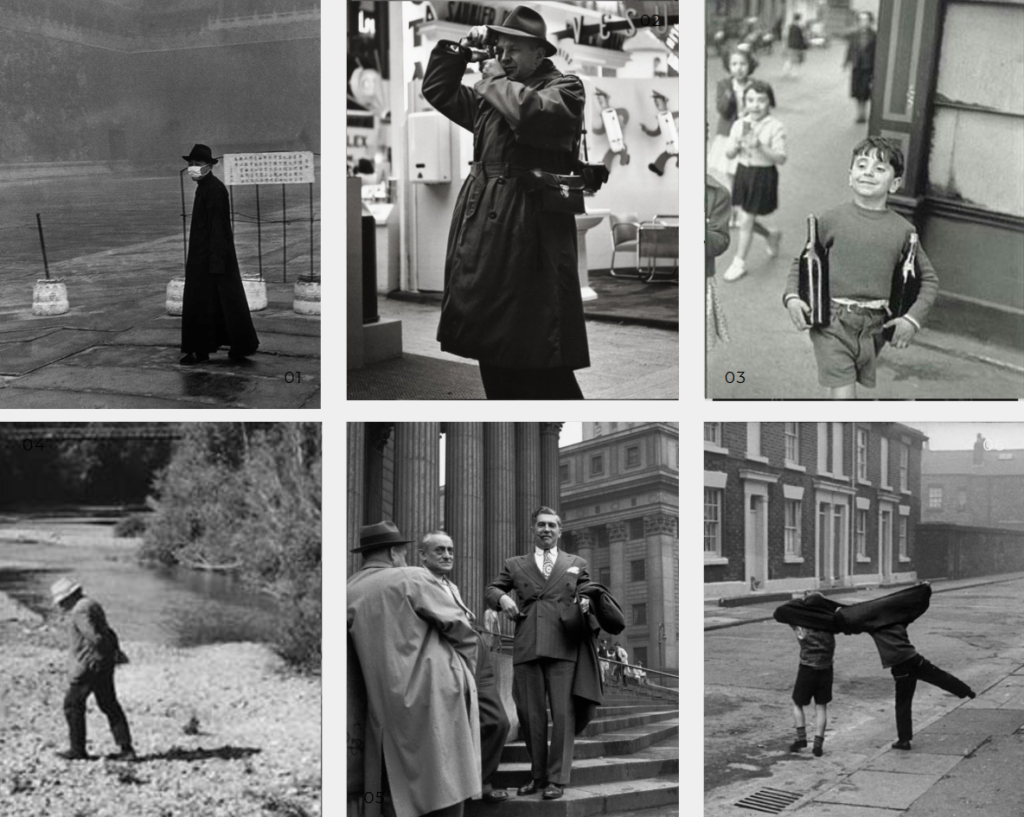
Henri Cartier Bresson famous Quotes
Personal Opinion
Henri Cartier Bresson’s work is really intriguing, I love how he captures very pure moments in time which show a story from a first look within the image but which also have a deeper meaning and story to each and every image.
The decisive moment definition – is the simultaneous recognition, in a fraction of a second, of the significance of an event as well as of a precise organisation of forms which give that event its proper expression.
He inspires me as I am a very creative person who enjoys creating deeper meanings and stories behind images which may look so simple however they create such a inspiring story behind them.
Matt Black – Black & White photography

Who is Matt Black?
Matt Black is a photographer who’s known for focusing on social issues like poverty and migration, especially in rural and underserved communities. He started his career with a passion for documentary photography, wanting to show the stories of people who are often overlooked in mainstream media. Born in California, his work really zooms in on the struggles people face in places most of us don’t think about, using his photos to give them a voice. Through his lens, he sheds light on important issues, making people stop and think about the bigger picture.
Using Documentary style –
Matt Black is all about documentary photography, meaning he captures real-life moments as they happen, without staging or altering them. His approach is all about authenticity, he doesn’t try to make things look prettier or more dramatic than they actually are. Instead, he focuses on showing the raw truth of people’s lives, especially those in difficult situations. Black’s photos don’t just tell you a story; they pull you right into the moment, making you feel like you’re standing there with the people in the photo, experiencing it with them.
what he focuses on –
Matt Black has always had a strong focus on showing the lives of people who are often left out of mainstream media, like those living in poverty or facing tough circumstances. His work isn’t just about taking photos of poor communities, it’s about telling their stories with respect and dignity. He doesn’t want to sensationalize or exploit the struggles people face; instead, he works to show the humanity behind the hardship. Whether he’s photographing migrant workers or people in rural towns, his goal is to capture the full picture of their lives, highlighting both the challenges they face and their resilience.
His context –
Matt Black often uses the geography and environment of his subjects’ surroundings to add depth to his photos. It’s not just about taking a picture of a person, it’s about showing where they live, work, or struggle, and how those places shape their lives. For example, when he photographs communities dealing with poverty, the landscapes or settings around them often tell as much of the story as the people themselves. By including these details, Black helps the viewer understand the bigger picture and how geography and social conditions are intertwined with the personal stories he captures.
His techniques –
Matt Black has a unique way of making his photos feel really impactful, and part of that comes from his choice of gear and style. He often uses a large format camera, which helps him capture super detailed and striking images. He also sticks to black-and-white photography, which might seem simple, but it actually makes his work stand out. The lack of color puts more focus on the textures, lighting, and emotions in the photo, so you really notice the mood and story behind the image. It’s all about giving the viewer a chance to feel something deeper, rather than just looking at a pretty picture.
What were his most known projects?
Matt Black’s projects are some of the most powerful examples of social documentary photography. One of his standout series is “The Geography of Poverty,” where he traveled across the U.S. to capture the harsh realities of poverty in different regions. He’s also worked on stories about migration and rural life, often focusing on communities that don’t get much attention. His long-term projects give him the chance to dive deep into these issues, showing a bigger, more complex picture of what life is like for people living in tough situations. Each project feels like a deep exploration of the challenges many face but rarely get seen.
Who did he influence?
Matt Black has received a lot of recognition for his powerful work, and it’s clear that his photos are making a real impact. He’s won awards and had his work featured in major exhibitions, which has helped bring attention to the social issues he covers. But beyond the accolades, his influence on other photographers is huge, especially those focused on documenting real-life struggles and social justice. Black’s ability to show the humanity in difficult situations has inspired many in the photography world, and his work continues to raise awareness about important topics like poverty and migration.
Photoshoot one –
Concept –
The first shoot is used to present documentary style photography where I will take images of my computer and have all the designing process presented on screen whilst I take the photos in order to show and represent the designing process. I will also use images in which show my expressions and how I felt whilst designing my hoodies.
Location –
For this photoshoot I am going to take almost all of the photos within my house, more specifically my bedroom with most the images featuring my desk and computer.
Equipment –
Artist reference for this shoot –
Henri Cartier Bresson
– Documentary style photographer
Photoshoot Two –
Concept –
For this shoot I am going to take images of my devices such as my phone and pc etc. showing the creation of the social media platforms for the brand and representing the time and effort it takes to create all the socials.
Location –
Anywhere in my house when using my phone however when taking photos of my pc the images will be taken in my bedroom.
Equipment –
Artist Reference for this shoot –
Henri Cartier Bresson
– documentary style photographer
Photoshoot three –
Concept –
For this shoot I am going to be taking photos of the sample hoodies arriving at my door in the box and then photos of the hoodies being unboxed and somehow representing the feelings of receiving the samples.
Location –
This shoot will be done within my house and front garden some images taken inside for the unboxing and photos taken outside of the door and garden with the parcels outside.
Equipment –
Artist Reference for this shoot –
Henri-Cartier Bresson – Documentary photography
Photoshoot four –
Concept –
For my fourth photoshoot I am going to gather a group of my friends who are willing to model for me. I am going to take them into my school studio and set up the camera to capture some portrait images of them wearing my hoodies.
I am going to use 4 separate models, three which are boys and one girl, I will take photos of each of them wearing each different colour hoodie whilst guiding them to do different poses and positions to really capture the hoodies and their portraits.
Location –
For this photoshoot I am going to be using my school photography studio. to create that studio effect to my photoshoot.
Equipment –
Artist Reference for this shoot –
Oliver Doran – portrait photographer
Photoshoot Five –
Concept –
For this photoshoot I am going to take documentary style photos of my hoodies bulk order and more images of all the extra supplies that are needed for my brand.
Location –
I will use my bedroom an create a home studio to take images of the products and the supplies.
Equipment –
Artist Reference for this shoot –
Henri-cartier Bresson – documentary style photography
Photoshoot Six –
Concept –
For this photoshoot I am going to take photos of money and the orders coming through online to represent the real start of the journey with selling these products.
Location –
I will do this photoshoot at my house, possibly in my room using a home made studio and using my pc.
Equipment –
Artist Reference for this shoot –
Henri Cartier Bresson – documentary style photograpy
Photoshoot Seven –
Concept –
For this photoshoot I am going to take images in the perspective of a customer ordering from me, the process of them ordering and waiting for the order to arrive to them then getting the package and openeing it.
I will then get some images of them trying it on and walking outside the house wearing it.
Location –
My house.
Equipment –
Artist Reference for this shoot –
Henri-Cartier Bresson – Documentary style photography

Genres I want to include:
Artist Studies : Environmental photographers
Arnold Newman
Who is Arnold Newman?
Arnold Abner Newman was an American photographer, noted for his “environmental portraits” of artists and politicians. He was also known for his carefully composed abstract still life images. In 2006, he was inducted into the International Photography Hall of Fame and Museum.

Arnold Newman
What inspired Arnold Newman?
Arnold Newman was partially influenced by Flemish Painters. Flemish Painters focus on many different kinds of genres whether its still life paintings, environmental paintings or even portraits there are so many genres of art within this field of painting.
Who inspired Arnold Newman?
Along side Flemish painters He also mentioned that the work of the Cubists, including Picasso, influenced the way he structures a photograph. Picasso was a Spanish painter, sculptor, printmaker, ceramicist and stage designer considered one of the greatest and most influential artists of the 20th century. Picasso is credited, along with Georges Braque, with the creation of Cubism.
Moodboard of Arnold Newman’s photography
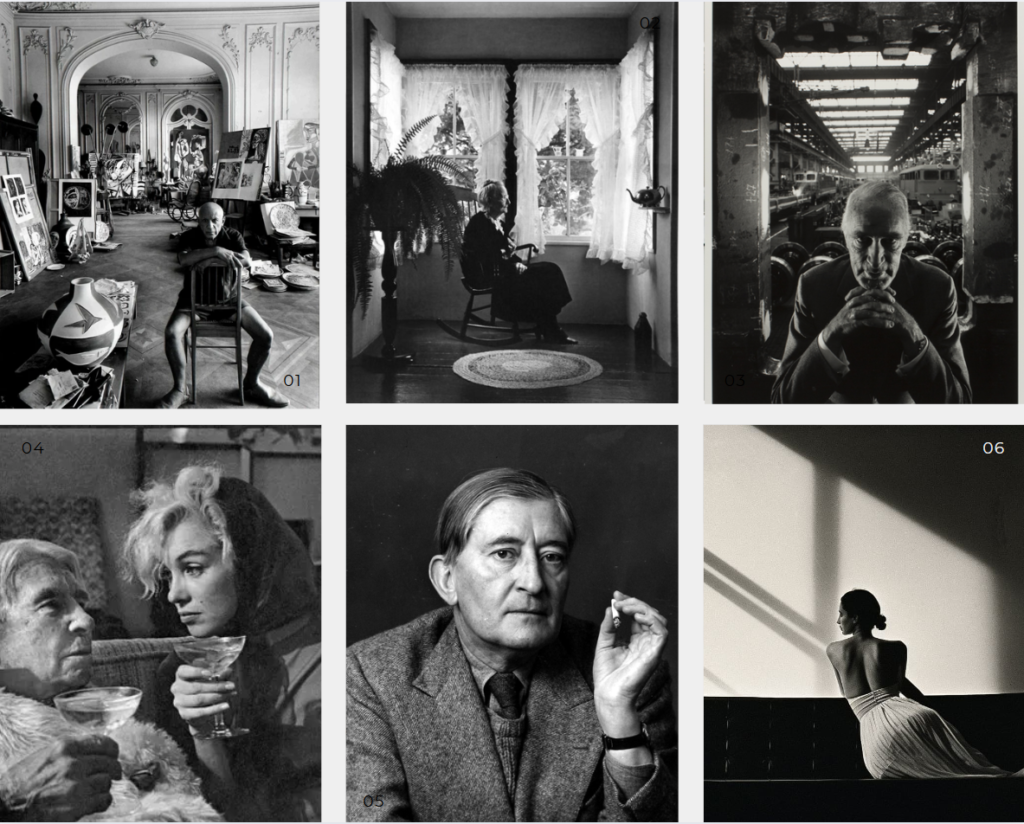
Personal Opinion
What I like about Arnold Newman’s work is that he uses people within their natural environment therefore he captures people to their full capacity as people often feel the most comfortable in their own personal environment. Although they do know they are being photographed many of the images still turn out very natural as if the camera wasn’t there.
Arnold uses quite a lot of natural lighting in his images, whether they are taken outside or close to windows letting in the natural sunlight and lighting in from the outside. Although all of his images are manipulated and changed to black and white the natural lighting within each image is still very clear and noticeable.
All of Arnold Newman’s photographs have a warm light feel to them even whilst all the images are black and white you can still see the warm, soft lighting within the photographs.
Arnold Newman uses a wide range of different perspectives, shapes and points of view within his images, some are up close and very detailed while others show a bigger picture with less of a focal point.
Artist study two – Street photographers/documentary
Henri Cartier Bresson

Who is Henri cartier Bresson?
Henri Cartier-Bresson was a French artist and humanist photographer considered a master of candid photography, and an early user of 35mm film. He pioneered the genre of street photography, and viewed photography as capturing a decisive moment. Cartier-Bresson was one of the founding members of Magnum Photos in 1947.
Who inspired Henri Cartier Bresson?
Cartier-Bresson’s photographic vision was shaped by a blend of artistic, philosophical, and documentary influences, ranging from Surrealism and Pictorialism to painting and the revolutionary spirit of the 20th century. His unique style, which emphasized capturing the essence of life’s fleeting moments, was an amalgamation of these diverse inspirations.
some of the types of people who inspired him:
What was Henri Cartier Bresson’s most famous piece?
Henri Cartier Bresson’s most famous piece was the Place de l’Europe, Behind Gare Saint Lazare (1932)

Image Description:
Cartier-Bresson’s impulsive masterpiece picturing a man suspended in mid-air as he hops over a large puddle creates a sense of anticipation as he captures the dynamic movement of an unaware participant in the decisive moment: the instant before his heel hits the water.
Henri Cartier Bresson Moodboard

Henri Cartier Bresson famous Quotes
Personal Opinion
Henri Cartier Bresson’s work is really intriguing, I love how he captures very pure moments in time which show a story from a first look within the image but which also have a deeper meaning and story to each and every image.
The decisive moment definition – is the simultaneous recognition, in a fraction of a second, of the significance of an event as well as of a precise organisation of forms which give that event its proper expression.
He inspires me as I am a very creative person who enjoys creating deeper meanings and stories behind images which may look so simple however they create such a inspiring story behind them.
Artist study three – portrait photography
Oliver Doran
who is Oliver Doran?
Oliver Doran is an internationally renowned portrait, editorial, and commercial photographer. Known for his ability to capture spontaneous, heartfelt moments with genuine emotions, his work has attracted clients from all over the world. After expanding his portfolio in the Middle East and returning to Jersey in 2020, Oliver now blends his global experience with a focus on capturing life’s most precious milestones.

What kind of photos does oliver doran take?
Oliver Doran takes a wide range of different portrait images of people in various different angles, he has taken portrait images for magazine covers, family shoots for memories and various other styles of portraits for many different occasions.
website quote – “At Oliver Doran Studios, we craft stunning, timeless, and iconic visual stories that rival the elegance of high-end magazine covers—capturing your true essence in every shot.”
Who and what has Oliver Doran worked with?
Based in Jersey, Oliver travels internationally for both private and commercial commissions. His work has taken him to cities like London, Paris, Malaga, and Dubai, where he collaborates with luxury brands such as Cartier and Dior. He’s also worked with major publications like GQ, Esquire, and Cosmopolitan, and photographed celebrities including Robert De Niro, Lewis Hamilton, and Colin Firth.
Here are all the brands and companies he has worked with:
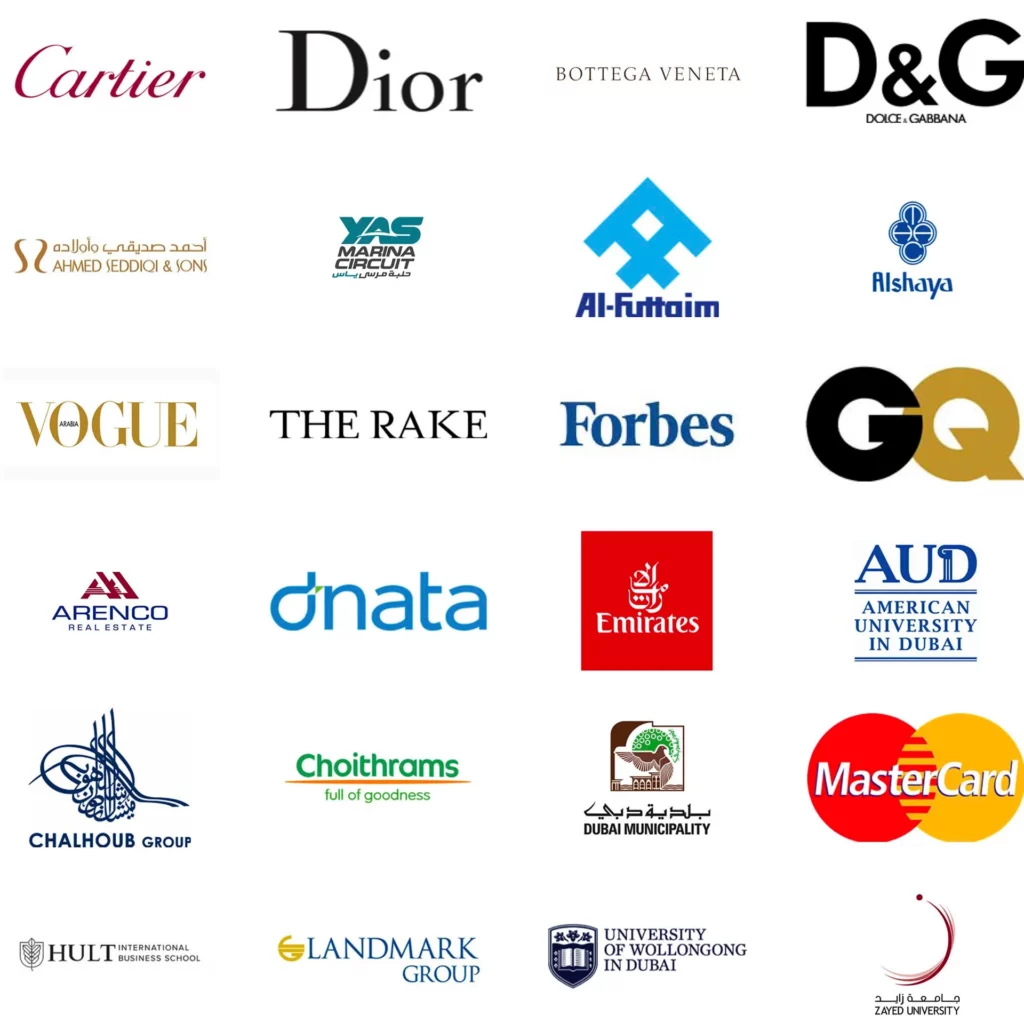
Oliver Doran moodboard
